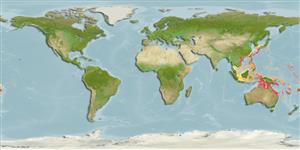>
Eupercaria/misc (Various families in series Eupercaria) >
Labridae (Wrasses) > Bodianinae
Etymology: Choerodon: Greek, choiros = a pig + odous = teeth (Ref. 45335); referrring to the prominent anterior canines of the species in this genus (Ref. 116605).
More on author: Günther.
Environment: milieu / climate zone / depth range / distribution range
Ecología
marino asociado a arrecife; rango de profundidad 5 - 35 m (Ref. 9823), usually 5 - 35 m (Ref. 27115). Subtropical; 25°C - 28°C (Ref. 27115)
Western Pacific: disjunct distribution, Ryukyus to Taiwan, then from New Caledonia to Queensland, Australia.
Tamaño / Peso / Age
Maturity: Lm ? range ? - ? cm
Max length : 30.0 cm TL macho / no sexado; (Ref. 2334)
Espinas dorsales (total) : 12; Radios blandos dorsales (total) : 8; Espinas anales: 3; Radios blandos anales: 10. Body with 7 or 8 pairs of alternating prominent red, blue, white and blackish bands. Pectoral fins with ii unbranched and 14 branched rays. Predorsal scales approximately 10 to 14, reaching forward in advance of posterior extent of orbit on dorsal midline of head. (Ref 9823)
Adults inhabit seaward reefs (Ref. 9710). Feed on mollusks, crustaceans, various worms, and echinoderms. Solitary and territorial species (Ref. 9710). Monogamous (Ref. 52884). Oviparous, distinct pairing during breeding (Ref. 205). Maximum depth reported from Ref. 27115.
Life cycle and mating behavior
Maturities | Reproducción | Spawnings | Egg(s) | Fecundities | Larva
Oviparous, distinct pairing during breeding (Ref. 205).
Randall, J.E., G.R. Allen and R.C. Steene, 1990. Fishes of the Great Barrier Reef and Coral Sea. University of Hawaii Press, Honolulu, Hawaii. 506 p. (Ref. 2334)
IUCN Red List Status (Ref. 130435)
Threat to humans
Harmless
Human uses
Pesquerías: comercial; Acuario: Comercial
Herramientas
Special reports
Download XML
Fuentes de Internet
Estimates based on models
Preferred temperature (Ref.
123201): 24.5 - 28.7, mean 27.4 °C (based on 486 cells).
Phylogenetic diversity index (Ref.
82804): PD
50 = 0.5000 [Uniqueness, from 0.5 = low to 2.0 = high].
Bayesian length-weight: a=0.01318 (0.00582 - 0.02984), b=3.05 (2.86 - 3.24), in cm total length, based on LWR estimates for this (Sub)family-body shape (Ref.
93245).
Nivel trófico (Ref.
69278): 3.4 ±0.40 se; based on food items.
Resiliencia (Ref.
120179): Medio, población duplicada en un tiempo mínimo de 1.4-4.4 años (Preliminary K or Fecundity.).
Fishing Vulnerability (Ref.
59153): Low vulnerability (20 of 100).
Nutrients (Ref.
124155): Calcium = 34.8 [16.2, 71.6] mg/100g; Iron = 0.597 [0.330, 1.168] mg/100g; Protein = 19.2 [16.4, 21.5] %; Omega3 = 0.212 [0.124, 0.366] g/100g; Selenium = 12.8 [6.5, 24.6] μg/100g; VitaminA = 68.1 [20.9, 281.8] μg/100g; Zinc = 0.959 [0.626, 1.641] mg/100g (wet weight);
